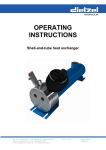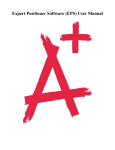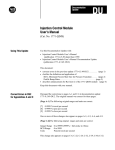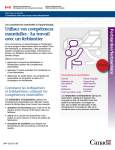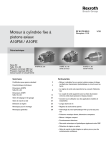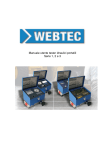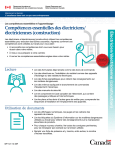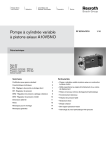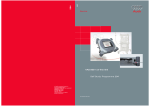Download User manual for Hose Safety Catch
Transcript
User manual for Hose Safety Catch Components Hose clamp (with elastomer insert) Wire guide Catch wire Velcro strap Fixing bracket Description of function In the event that the connection between the hose and the fitting comes loose under pressure, the hose safety wire prevents the hose from throwing (whipping) because the catch wire tightens under tension. The length of the catch wire is to be laid out so that the hose can slide out of the fitting (pressure release). Application / Conditions of use The hose safety catch has been developed and tested with reference to the following standards: DIN EN 853, DIN EN 856, EN 857, SAE J517 DIN 2353, SAE J518 These contain references to hoses and fittings. Minimum lengths of hose when fitted both sides (left/right) of the catch: Hose nominal diameters DN 06 to 31: 600 mm DN 38 to 51: 700 mm DN 60 to 76: 1000 mm It is essential to ensure that the use complies with these standards. Guarantee claims are invalid when these assembly instructions are not complied with. The maximum operating pressure of the hose must not be exceeded. In case of use at higher operating pressures, no liability will be accepted for sufficient strength of the system. Dipl. Ing. K. Dietzel GmbH, Leedenstraße 10, 04626 Beerwalde, Germany Translation of the German original instructions for use (version: 31.03.2014) page 1 / 4 Please note the following for the use of the hose safety catch in an environment subject to risk of fire or explosion: The hose safety catch components are made of metallic material. Die risk of sparking is very low, but generally given. A minimum spacing between hoses under pressure is still required when using the hose safety catch, because the length of the catch wire is designed so that pressure can be released in case of damage (see description of function). Recommended minimum separation: 0.5 m Installation / Assembly The hose safety catch consists of many single parts, which are fitted together on the hose by technicians to form the safety device. Make sure before starting assembly that the hose system is not under pressure. Observe the following assembly instructions. Assembly instructions • Select the correct fixing elements. • Position the wire guide on the hose with the hose clamp • Set the spacing to 45 mm between hose clamp and the end of the ferrule [Fig. 1]. If the fitting has an elbow, you must also take the position of the wire guide to the pipe bend into account [Fig. 2]. • Tighten the bolt on the clamp until the rubber insert (elastomer profile) is secure on the hose, but still allows the hose to swell according to the permissible operating pressure. • Lay the catch wire on the hose [Fig. 3]. Take the ends of the wire and lead them under the hose so that the wires cross. This forms a loop [Fig. 4]. Then insert the ends of the wire through the large hole in the wire guide. This produces another crossing point [Fig. 5]. • Before fitting the standard fixing bracket on a DKO connection, you must insert the ends of the wire into the slot [Fig. 6]. Using the two-piece version, the assembly can be done afterwards [Fig. 7]. The torques of the fixing bolts is 6,0Nm for thread M5 and 10,0Nm for M6 thread. • After the assembly of the bracket, secure the catch wire with a Velcro band to the ferrule [Fig. 8]. • The assembly to a hose with a SAE flange is analogous to a DKO fitting [Fig. 9]. When using fittings from other suppliers, you need to assure that the free distance between end of nut and the counterpart is big enough for the fixing plate. The plate may not be jammed to ensure the sealing of the hydraulic fitting. Dipl. Ing. K. Dietzel GmbH, Leedenstraße 10, 04626 Beerwalde, Germany Translation of the German original instructions for use (version: 31.03.2014) page 2 / 4 Fig. 1 Fig. 2 Fig. 3 Fig. 4 Fig. 5 Fig. 6 Fig. 7 Fig. 8 Fig. 9 Operational safety notices When assembling the hose safety catch onto hoses which move gg • Rubbing or grazing to the skin through safety components • Pinching of hands (fingers) through the changing position of the wire Practice increased caution in the danger area. Dipl. Ing. K. Dietzel GmbH, Leedenstraße 10, 04626 Beerwalde, Germany Translation of the German original instructions for use (version: 31.03.2014) page 3 / 4 Storage / Maintenance / Care Store the assembled hose safety devices sorted in a dry place. Individual parts may not be exchanged. The hose safety catch itself is maintenance-free. When used in machines, test bays etc., where increased oscillation, vibration or pulsation of the hose can be expected, the hose safety catch must be checked at regular intervals (e.g. with machine maintenance work) to ensure the hose clamp is secure and does not have any damage. In case of damage to individual parts, the entire hose safety catch must be replaced. The same applies when the safety catch comes into action after the failure of a hose connection. EC conformity declaration for machines (directive 2006/42/EC) The manufacturer hereby declares… Dipl. Ing. K. Dietzel GmbH, Leedenstraße 10, 04626 Beerwalde, Germany that the safety device … for the holding of a hose in case of failure “Hose Safety Catch” of type SD-XXXX1-XXX2SLXXXX3 und SF-XXXX1-XXX2-SLXXXX3 1 Clamping range of the hose clamp Diameter of hole in the bracket 3 Wire length 2 conforms to the provisions of the above directive. The following harmonised standards have been applied: DIN EN ISO 12100, parts 1 and 2………………… Safety of machinery – basic terms DIN EN ISO 14121-1……………………………... Safety of machines – risk evaluation Name/address of the person responsible for documentation: Nicky Groß, Design Department, Leedenstraße 10, 04626 Beerwalde, Germany Dipl. Ing. K. Dietzel GmbH, Leedenstraße 10, 04626 Beerwalde, Germany Translation of the German original instructions for use (version: 31.03.2014) page 4 / 4




